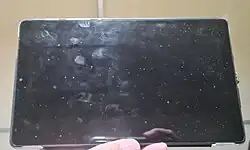Saliva spittle

Saliva spittle or saliva spray refers to the particles of saliva involuntarily expelled from the mouth during speech, especially during vigorous articulation or the pronunciation of explosive consonants (such as /p/, /b/, /t/). These salive projections, which are completely distinct from respiratory droplets, are produced by fluid dynamics in the oral cavity rather than by pulmonary exhalation.[1] They are often visible and noticeable on the face of the person listening or they may remain as marks on a mobile phone screen when speaking hands-free
Description

The term describes the involuntarily act of spitting or spraying saliva while talking, a phenomenon completely different from general respiratory droplets, although the term "speech droplet" has been largely associated with the broader "respiratory droplet" category, especially in scientific and public health contexts.
Here are some alternatives, from most to least formal:
- Sialoquent: This is an extremely rare and archaic word, but it perfectly describes someone who "spits much in their speech." Its etymology comes from the Greek "síalon" (saliva) and Latin "loqui" (to speak).
- Spittle: This is a more common and direct noun for the saliva that is ejected from the mouth. You could say "He was prone to sending spittle flying while he spoke."
- Sputtering: This verb describes the act of speaking quickly and angrily in a way that causes a spray of saliva to be emitted. This term is also used for a spluttering sound, as from a car engine.
- Splattering or Spraying: These are more direct, informal verbs. The French phrase "lancer des postillons"[2] translates directly to "to spray spittle." A common colloquial expression for this is "Say it, don't spray it."
Characteristics and Formation
They form when tongue movements, lip bursts, or airflow turbulence disrupt the thin film of saliva coating the inside of the mouth, ejecting saliva spittle into the air.[3]
Saliva spittle is typically:[4]
- Larger (100 µm to a few mm in diameter) than respiratory aerosols (<5 µm) and often completely visible and noticeable on the skin.
- Projected short distances (usually <1 meter) due to their mass, though forceful speech can extend their range.
- Composed of saliva, oral mucus, and potential oral microbiota (e.g., Streptococcus).
Differences from respiratory droplets
Modern studies (Anfinrud et al., 2020) have quantified their role in disease spread, particularly during the COVID-19 pandemic, where masks reduced their dispersion by 99 %.[5]
| Feature | Saliva spittle | Respiratory Droplets |
|---|---|---|
| Origin | Oral cavity (saliva) | Lungs, bronchial tract |
| Size | 100 µm to some mm (often visible) | 0.1–10 μm (smaller, aerosolizable) |
| Expulsion Force | Moderate (speech-dependent) | High (coughing/sneezing) |
| Disease Relevance | Low transmission risk (e.g., colds) | High (COVID-19, influenza, TB) |
| Dispersion | Fall quickly, limited airborne time | Can remain suspended for hours |
History
The study of saliva spittle spans centuries, with early observations rooted in public hygiene, theater performance, and later, germ theory.
Early Observations (Pre-20th Century)
- Ancient Rome: Rhetoricians like Quintilian (1st century CE) advised orators to avoid "excessive sputum" during speeches, suggesting early awareness of saliva projection.[6]
- 18th–19th Century: French physicians coined the term postillons (from poster, "to spit") to describe visible saliva droplets emitted during speech, linking them to tuberculosis spread in close quarters.[7]
Scientific Formalization (20th Century)
- 1930s–1940s: Studies on phonetics (e.g., by Peter Ladefoged) noted that plosive consonants (/p/, /t/, /k/) produce more droplets due to abrupt airflow.[8]
- 1970s: High-speed photography confirmed saliva ejection patterns during speech (Lighthill, 1975).[9]
Modern Era (21st Century)
- 2019–2022: The COVID-19 pandemic spurred research into speech-generated droplets. An NIH study (2020) showed loud speech emits ~1,000 droplets per minute, with masks reducing counts by 99% (Anfinrud et al.). MIT (2021) demonstrated that "voiced" sounds (e.g., /a/, /i/) aerosolize more than whispers (Bourouiba Lab).
- Cultural Shifts: Increased use of plexiglass barriers in public spaces highlighted distinctions between large speech droplets (blocked) and aerosols (not blocked).[10]
Terminology Evolution
- Pre-COVID: Terms like "spraying" or "spittle" were colloquial.
- Post-COVID: The term "saliva spittle" entered technical discourse to differentiate from respiratory aerosols (e.g., in WHO reports).
Scientific and Social Relevance
- Communication Hygiene: Saliva spittle contribute to "spraying while talking", a noted issue in public speach, acting, and close conversations. Studies suggest masks reduce their spread significantly.[11]
- Disease Transmission: While less infectious than respiratory aerosols, saliva spittle can transmit oral pathogens (e.g., Epstein-Barr virus, common cold). Superspreader events (e.g., choirs, crowded debates) may involve saliva spittle emission from speech.[12]
- Mitigation:[10]
- Lip balm or hydration reduces droplet formation by thinning saliva.
- Physical barriers (e.g., plexiglass) block saliva spittle but do not block aerosols.
- Theater : Actors use speach techniques to minimize them.
See also
References
- ^ Maton, Anthea 1993.. Human biology and health. Prentice Hall. ISBN 0-13-981176-1
- ^ Académie française. "9e édition". Dictionnaire de l’Académie française (in French). Retrieved 2025-08-18.
- ^ Bourouiba, Lydia (2021-07-13). "Fluid Dynamics of Respiratory Infectious Diseases". Annual Review of Biomedical Engineering. 23 (1): 547–577. doi:10.1146/annurev-bioeng-111820-025044. ISSN 1523-9829. PMID 34255991.
- ^ Anfinrud, Philip; Stadnytskyi, Valentyn; Bax, Christina E.; Bax, Adriaan (2020-05-21). "Visualizing Speech-Generated Oral Fluid Droplets with Laser Light Scattering". New England Journal of Medicine. 382 (21): 2061–2063. doi:10.1056/NEJMc2007800. ISSN 0028-4793. PMC 7179962. PMID 32294341.
- ^ Randall, K.; Ewing, E. T.; Marr, L. C.; Jimenez, J. L.; Bourouiba, L. (2021-10-12). "How did we get here: what are droplets and aerosols and how far do they go? A historical perspective on the transmission of respiratory infectious diseases". Interface Focus. 11 (6). The Royal Society. doi:10.1098/rsfs.2021.0049. hdl:1721.1/148444. ISSN 2042-8901. PMC 8504878. PMID 34956601.
- ^ Prus, Robert (2022-07-31). "Influence Work, Resistance, and Educational Life-Worlds: Quintilian's [Marcus Fabius Quintilianus] (35-95 CE) Analysis of Roman Oratory as an Instructive Ethnohistorical Resource and Conceptual Precursor of Symbolic Interactionist Scholarship". Qualitative Sociology Review. 18 (3). Uniwersytet Lodzki (University of Lodz): 6–52. doi:10.18778/1733-8077.18.3.01. hdl:11089/42687. ISSN 1733-8077. Retrieved 2025-04-16.
- ^ Académie française. "9e édition". Dictionnaire de l'Académie française (in French). Retrieved 2025-04-16.
- ^ Hickey, Raymond, ed. (2010-04-09). The Handbook of Language Contact. Wiley. doi:10.1002/9781444318159. ISBN 978-1-4051-7580-7. Retrieved 2025-04-16.
- ^ Levinson, Stephen E. (2024-10-29). "Articulatory speech synthesis from the fluid dynamics of the vocal apparatus". WorldCat.org (in Spanish). Retrieved 2025-04-16.
- ^ a b Verma, Siddhartha; Dhanak, Manhar; Frankenfield, John (2020-06-01). "Visualizing the effectiveness of face masks in obstructing respiratory jets". Physics of Fluids. 32 (6). Bibcode:2020PhFl...32f1708V. doi:10.1063/5.0016018. ISSN 1070-6631. PMC 7327717. PMID 32624649.
- ^ Asadi, Sima; Bouvier, Nicole; Wexler, Anthony S.; Ristenpart, William D. (2020-06-02). "The coronavirus pandemic and aerosols: Does COVID-19 transmit via expiratory particles?". Aerosol Science and Technology. 54 (6): 635–638. Bibcode:2020AerST..54..635A. doi:10.1080/02786826.2020.1749229. ISSN 0278-6826. PMC 7157964. PMID 32308568.
- ^ Stadnytskyi, Valentyn; Bax, Christina E.; Bax, Adriaan; Anfinrud, Philip (2020-06-02). "The airborne lifetime of small speech droplets and their potential importance in SARS-CoV-2 transmission". Proceedings of the National Academy of Sciences. 117 (22): 11875–11877. Bibcode:2020PNAS..11711875S. doi:10.1073/pnas.2006874117. ISSN 0027-8424. PMC 7275719. PMID 32404416.
External links
- Carbone, Francesca; Bouchet, Gilles; Ghio, Alain; Legou, Thierry; André, Carine; Lalain, Muriel; Petrone, Caterina; Giovanni, Antoine (2024-12-03). "Investigating droplet emission during speech interaction". Language Resources and Evaluation. doi:10.1007/s10579-024-09789-x. ISSN 1574-020X.